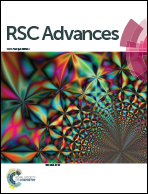Structural evolution, sequential oxidation and chemical bonding in tri-yttrium oxide clusters: Y3Ox− and Y3Ox (x = 0–6)†
Abstract
We report a systematic and comprehensive investigation on the electronic structures and chemical bonding of a series of tri-yttrium oxide clusters, Y3Ox−/0 (x = 0–6), using density functional theory (DFT) calculations. The generalized Koopmans' theorem was applied to predict the vertical detachment energies (VDEs) and simulate the photoelectron spectra (PES) for Y3Ox− (x = 0–6) clusters. A trend of sequential oxidation is observed from Y3O− to Y3O6−. All of these clusters tend to form structures with a capped oxygen atom. For Y3Ox−/0 (x = 2–4), the O atoms prefer the bridging sites of Y3O−/0, whereas the fifth O atoms for Y3O5−/0 are bonded to the terminal sites. In particular, the ground states of Y3O6−/0 are found to be interesting species, which may be viewed as molecular models for dioxygen activation by Y3O4−/0. σ- and π-aromaticity is found in Y3− by the molecular orbital analysis and Adaptive Natural Density Partitioning (AdNDP) analysis. Molecular orbital analyses are performed to analyze the chemical bonding in the tri-yttrium oxide clusters and to elucidate their electronic and structural evolution.


 Please wait while we load your content...
Please wait while we load your content...